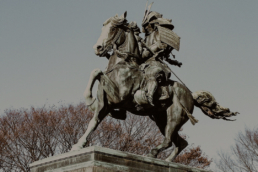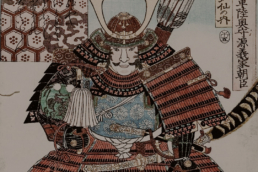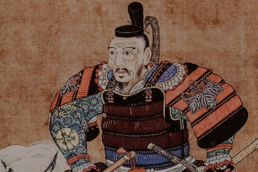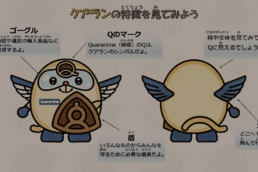Japan History: Maeda Toshiie
Maeda Toshiie nacque il 15 gennaio 1538 (l'attuale Nagoya) quarto figlio di Maeda Toshimasa, che deteneva il Castello di Arako, e morì il 27 aprile 1599. E' conosciuto per essere uno dei principali generali di Oda Nobunaga dopo il periodo Sengoku.
Maeda Toshiie, il capo del clan Maeda
Autore: SaiKaiAngel
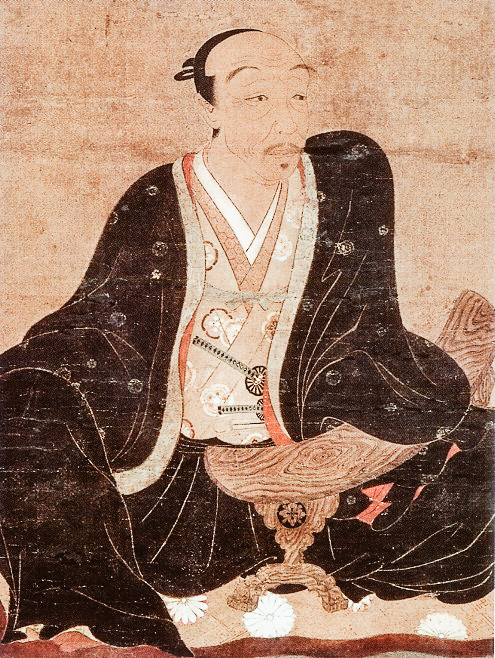
photo credits: wikimedia.org
Suo padre era Maeda Toshimasa e sua moglie Maeda Matsu. Quarto di sette fratelli, il suo nome d'infanzia era "Inuchiyo” e la sua arma preferita era uno yari, per questo era noto come "Yari no Mataza" o Matazaemon. Il grado più alto che ha ricevuto fu quello di Grande Consigliere Dainagon.
Per ordine di Nobunaga, Maeda Toshiie fu ricompensato con la nomina di capo del clan Maeda, nonostante avesse quattro fratelli maggiori. Questa posizione fu ricevuta nel 1560 alla morte di suo padre. Proprio come Oda Nobunaga, anche Toshiie era un delinquente e sembra fosse diventato, in gioventù, anche amico di Kinoshita Tokichiro, più famoso con il nome di Toyotomi Hideyoshi. Sembra che Toshiie fosse chiamato Inu (cane) da Nobunaga proprio per la sua natura riservata e severa, in contrasto con la natura loquace di Hideyoshi.
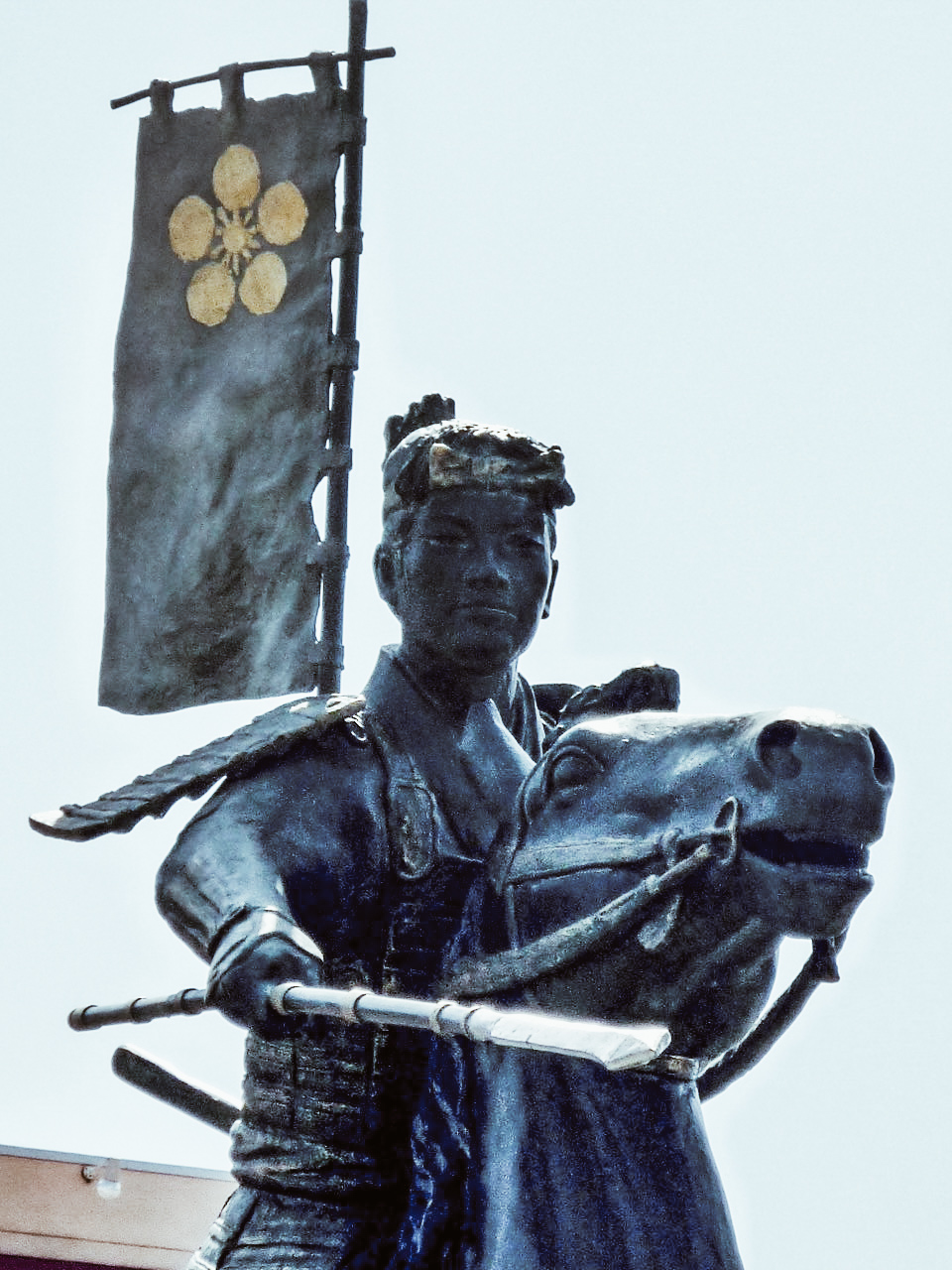
photo credits: samurai-world.com
La vita militare
Toshiie iniziò la sua carriera come membro del akahoro-shū sotto il comando personale di Oda Nobunaga. In seguito divenne un capitano di fanteria (ashigaru taishō) sempre nell'esercito di Oda Nobunaga. Durante la sua carriera militare, Toshiie conobbe molte figure importanti, come Hashiba Hideyoshi, Sassa Narimasa, Akechi Mitsuhide, Takayama Ukon e tanti altri che abbiamo precedentemente visto nel nostro blog. Egli fu anche l’eterno rivale di Tokugawa Ieyasu. Dopo aver sconfitto il clan Asakura, Maeda combatté sotto Shibata Katsuie nella zona di Hokuriku.
Maeda Toshiie partecipò a varie situazioni di guerra: lo vediamo nella battaglia di Okehazama del 1560 nell’assedio di Inabayama del 1567, nelle battaglia di Anegawa del 1570, di Nagashino del 1575 e di Tedorigawa del 1577, nell’assedio di Suemori del 1584 e di Odawara nel 1590. Alla fine gli fu concesso il feudo di Fuchu e un han (dominio Kaga) che attraversava le province di Noto e Kaga. Nonostante le sue piccole dimensioni, Kaga era una provincia altamente produttiva che alla fine si sarebbe trasformata nel più ricco han del Giappone nel periodo Edo, con un patrimonio netto di 1 milione di koku.
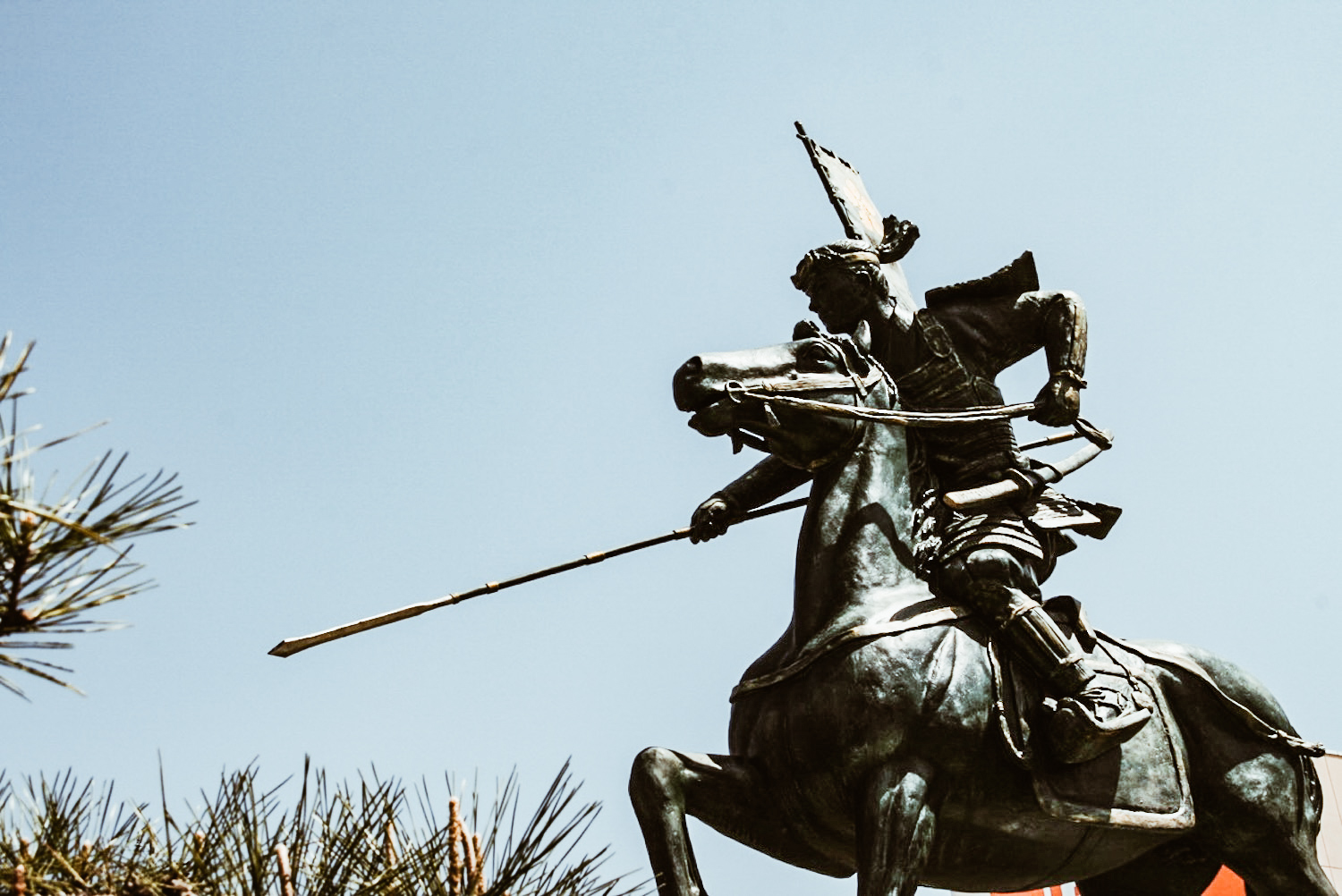
photo credits: samurai-world.com
Maeda Toshiie ha avuto un gruppo centrale di vassalli senior molto capaci. Alcuni, come Murai Nagayori e Okumura Nagatomi, mantennero una lunga tradizione con i Maeda.
Dopo l'assassinio di Nobunaga a Honnō-ji, di Akechi Mitsuhide e la successiva sconfitta di Hideyoshi da parte di Mitsuhide, Maeda Toshiie combatté contro Hideyoshi sotto il comando di Shibata nella battaglia di Shizugatake. Dopo la sconfitta di Shibata, Toshiie lavorò per Hideyoshi e divenne uno dei suoi principali generali. Più tardi fu costretto a combattere un altro dei suoi amici, Sassa Narimasa. Narimasa fu abbattuto da Toshiie in seguito alla grande vittoria di Maeda nella battaglia del castello di Suemori. Prima di morire nel 1598, Hideyoshi nominò Maeda Toshiie nel consiglio dei Cinque Anziani per sostenere Toyotomi Hideyori fino a quando non fu abbastanza grande da assumere il controllo. Nonostante questo, riuscì a sostenere Hideyori solo per un anno prima di morire. Il successore fu suo figlio Toshinaga.
La famiglia Maeda
La famiglia di Maeda Toshiie ebbe un ruolo molto importante nella sua vita. Sua moglie, Maeda Matsu, molto famosa perchè esperta nelle arti marziali, fu molto determinante per l'ascesa al successo di Toshiie.
Il fratello maggiore di Maeda Toshiie, Maeda Toshihisa, adottò Maeda Toshimasu (più famoso con il nome Maeda Keiji). Maeda Toshimasu prestò servizio sotto Oda Nobunaga insieme a suo zio. Toshimasu era originariamente destinato a ereditare la direzione della famiglia Maeda; tuttavia, dopo che Oda Nobunaga sostituì Toshihisa con Toshiie come capofamiglia dei Maeda, perse questa posizione. Forse a causa di questa perdita di eredità, Toshimasu fu ben noto per i continui litigi con suo zio Maeda Toshiie.
Maeda Toshiie morì nel 1658 all'età di 64 anni, e la sua tomba è nel cimitero Maeda di Nodayama a Kanazawa.
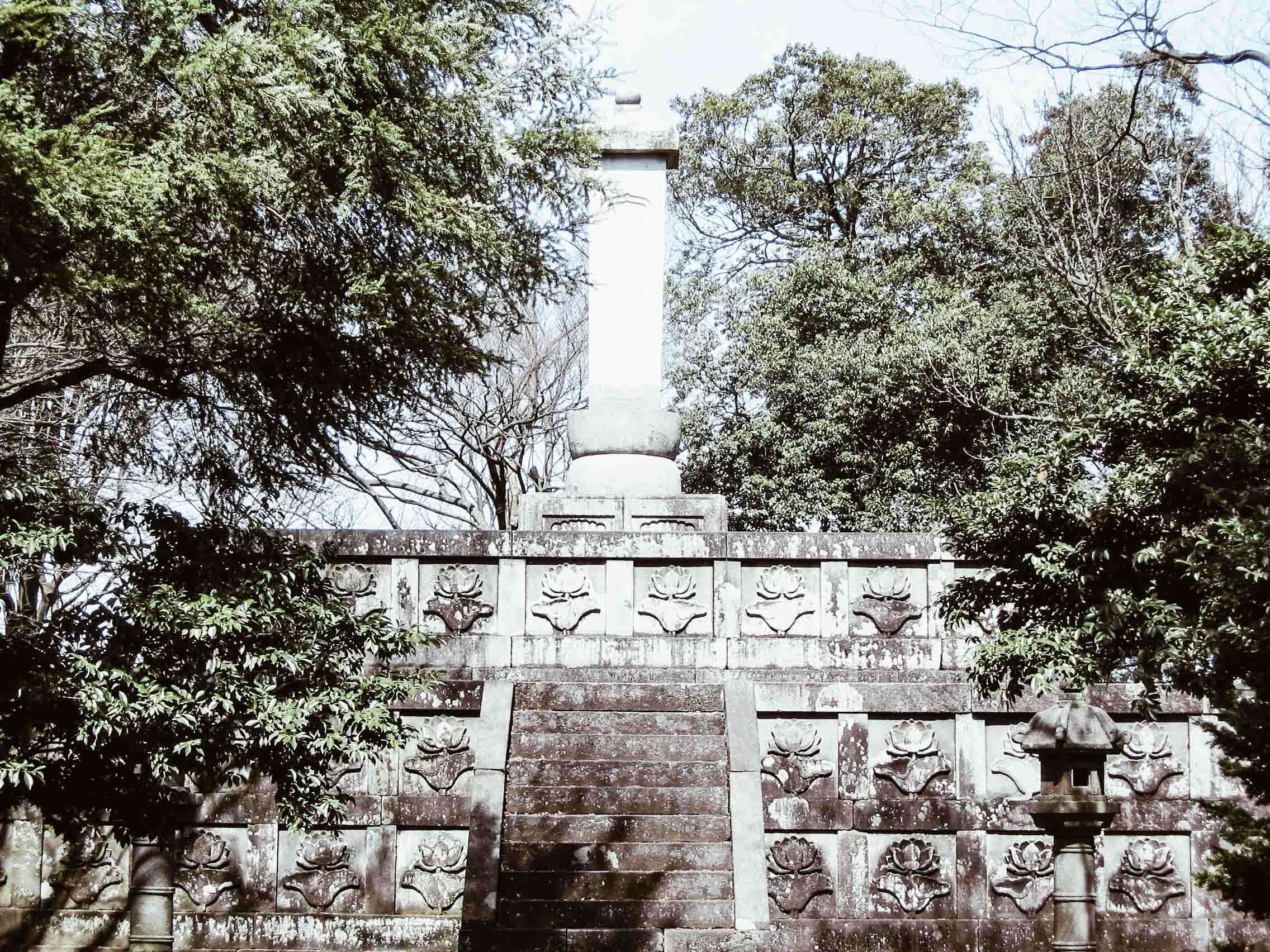
photo credits: wikimedia.org
Tutto ciò che c'è da sapere sui Maneki Neko
Sicuramente avrete visto i Maneki Neko, sia che voi siate o no cultori della tradizione giapponese. Vogliamo dare a questo meraviglioso e fortunato gattino giapponese un’attenzione particolare? Osserviamoli un po’ più da vicino.
Maneki Neko, il gatto porta fortuna dal Giappone
Autore: SaiKaiAngel
Noto anche come “gatto fortunato” è famoso in tutto il mondo. Il maneki-neko è un vero simbolo giapponese, con origini a Tokyo nel periodo Edo.
Originariamente i Maneki Neko erano realizzati in legno, metallo, porcellana o ghisa. Oggi si possono trovare in tutti i tipi di materiali, in particolare plastica.
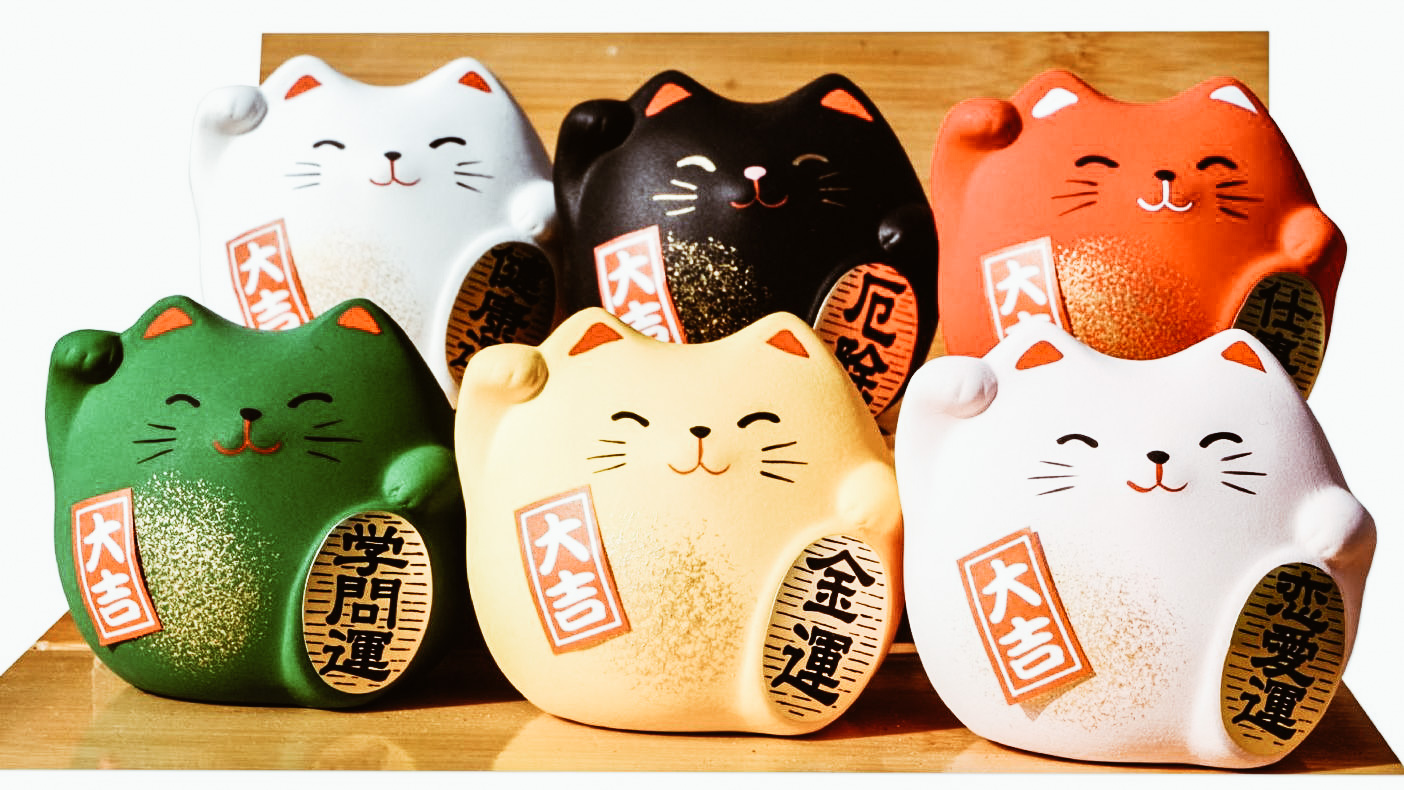
photo credits: www.dailyartmagazine.com
Le origini
Le origini sono avvolte nel mistero. Esistono alcuni racconti ed il più famoso è quello del samurai che sotto la pioggia sotto un grande albero di fronte a un tempio venne chiamato con un cenno della zampa. Il samurai quindi si diresse verso di lui e proprio in quel momento, un lampo di luce colpì l'albero sotto il quale era stato pochi istanti prima. Il gatto salvò quindi il samurai da morte certa.
Un'altra storia racconta di un negoziante che prese un gatto sotto la pioggia, e il gatto si sedette davanti al negozio, facendo cenno ai clienti di entrare, come segno di ringraziamento.
Un’altra leggenda, forse un po’ più bizzarra, ruota attorno a una cortigiana che amava il suo gatto domestico. Il proprietario, convinto che il gatto fosse posseduto, si tagliò la testa nel tentativo di esorcizzarlo, proprio mentre un serpente stava per mordere la cortigiana. La testa decapitata volò in aria e atterrò sul serpente, uccidendolo all'istante e salvando la ragazza. La ragazza si sentì disperata a causa della perdita e, per darle un sorriso qualcuno le fece una statuetta del suo gatto, sembra che così nacque il primo maneki-neko.
Le differenze tra i Maneki Neko
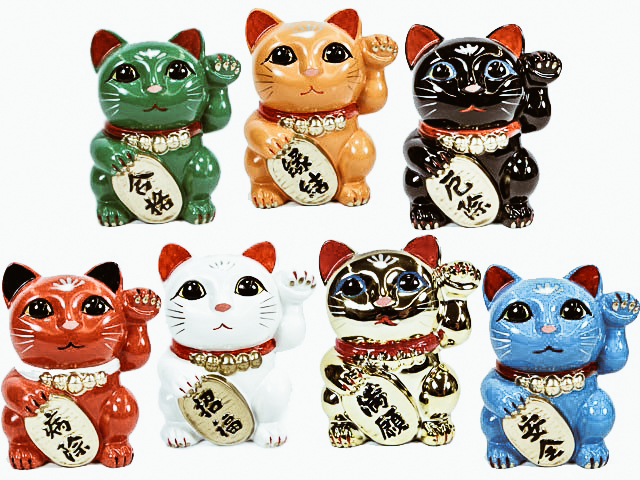
photo credits: @punamkhokhar
Questi gattini sembrano tutti uguali, ma se li guardate attentamente, potrete scoprire anche piccolissime variazioni che ne cambiano il significato.
Ad esempio, a seconda della posizione della zampa, il significato cambia
- Zampa sinistra sollevata: attira i clienti e buoni affari. Quindi con la zampa sinistra sollevata è adatto alle imprese, ai negozi e alle attività che si svolgono principalmente durante la notte come locali notturni, bar e discoteche.
- Zampa destra sollevata: augura denaro e buona fortuna.
- Entrambe le zampe sollevate: può significare "doppia fortuna!" e protezione dalla sfortuna, anche se il gesto può anche essere visto come un tifo celebrativo. Ovviamente le zampe devono essere ad altezza diversa, perchè alla stessa altezza significherebbero “arresa” e ovviamente non è il caso del nostro Maneki-Neko.
Possiamo ogni tanto anche trovare una moneta insieme al Maneki-Neko e questo, ovviamente rappresenta prosperità, ricchezza e denaro.
La pettorina e la campana sono generalmente associati alla protezione e all'abbondanza.
A chi regalare i Maneki Neko?
Ovviamente, a seconda della persona che vogliamo omaggiare, il Maneki Neko sarà posizionato diversamente. Come trovare il posto più giusto? Leggete qui:
- A casa: va posizionato nella parte sud-est della casa, che è l’ area ricchezza/denaro
- Per il lavoro: di solito il Maneki Neko viene tenuto vicino agli ingressi in modo tale che le persone che entrano possano effettivamente vederlo. Nel caso ciò non fosse possibile, può essere tenuto nell’area nord-est dei locali commerciali.
- Per gli uffici: posizionate il vostro Maneki Neko il più vicino possibile all'ufficio.
Ovviamente, anche a seconda del colore, il significato cambia, andiamo a vederli tutti:
- Tricolore: attira buona fortuna, ricchezza, prosperità.
- Bianco: colore della purezza, i Maneki Neko bianchi attirano appunto la purezza e la felicità.
- Nero: sono visti come delle guardie. Proteggono dalle energie negative e dal male. Inoltre aiutano a scacciare gli stalker e forniscono sicurezza, conforto e pace.
- Dorato: il colore dorato è associato a ricchezza e denaro. Questo Maneki-Neko attira benefici materiali e monetari e per questo si trovano molto nei negozi, ristoranti e altri luoghi di lavoro.
- Rosso: il rosso, come il nero, è un protettore ed è usato per proteggersi dal male e dalle malattie. È bene tenerne uno nella stanza dei bambini.
- Rosa: il rosa è il colore dell'amore, quindi questo Maneki-Neko attrae amore e romanticismo.
- Verde: questo Maneki-Neko aiuta gli studenti ad aumentare la concentrazione verso gli studi, proteggendoli dalle malattie ed aiutandoli a guarire nel caso ce ne fosse bisogno.
- Blu: attira pace, armonia e felicità per i membri della famiglia.
Tre modi per dire "Ti Amo"
"Ti Amo, I love you" Come dirlo in Giapponese? Ci sono tanti tipi di amore, perchè dovremmo esprimere amore solamente in un modo? I giapponesi la sanno lunga, sanno che ogni tipo di amore ha bisogno di un modo per essere espresso, un modo completamente personale.
Ti amo / I Love you, ecco come dirlo in Giapponese
Autore: SaiKaiAngel | Fonte: SoraNews24
Tutto questo, pensate, accade in un paese che è visto come “freddo e distante”. Forse, pensando a questo, dovremmo capire che freddo e distante non è, anzi. E’ un paese che dà la giusta importanza sia alla storia, sia alla tradizione che ai sentimenti.
Cominciamo a guardare tutti i modi di dimostrare amore in giapponese, analizziamoli uno ad uno.
1. Suki - "Mi piaci"

Questo è il modo più usato e più famoso, perchè si trova in molti testi dell’animazione giapponese. Lo analizziamo per primo anche perchè è il meno “profondo”, infatti più che amore, può significare anche “mi piace”. Puoi tranquillamente dire "Ramen ga suki desu" che nessuno ti vedrà come un pazzo innamorato di un piatto di ramen, bensì tutti capiranno che a te piace il ramen. Così si può usare suki per esprimere appunto un apprezzamento per un cantante o un attore.
Proprio per questo, suki può creare della confusione. Se sentiamo questa parola, si potrebbe incorrere nella domanda se piacciamo per davvero come persona o semplicemente come un piatto di ramen, appunto. E’ un significato molto flessibile, per niente sicuro, nonostante tutto viene utilizzato all’inizio di ogni storia d’amore. Quando vuoi dichiararti a qualcuno, puoi usare suki desu per farlo. Molto importante a quel punto, sarà il MODO in cui lo fai, devi fare in modo di far capire all'altra persona che hai intenzioni serie e non sei solamente un piatto di ramen. Ci vuole convinzione nella voce, non è un semplice “mi piace”. Con una grande convinzione, allora avrà la colorazione giusta dell’innamoramento.
2. Koi - I love you

Non stiamo parlando della carpa, ma del secondo modo che i giapponesi usano per parlare d’amore. Qui siamo nel campo dell’ “amore romantico”. Koi è l’'emozione giovane e passionale, ma viene raramente usato per dire “ti amo”. Possiamo forse avvicinarlo ad "I love you" degli americani, che può voler dire sia ti amo che ti voglio bene. Tuttavia, Il verbo koi suru è più vicino a "essere innamorato" o "essere romanticamente coinvolto". Infatti, la parola Koi viene usata per Koibito che significa amante.
3. Ai - Ti amo

Ed eccoci arrivati al più famoso, il termine più usato per la parola Amore.
Ai è un sostantivo che significa "amore", ma può essere usato per qualcosa di più del semplice affetto romantico. Ai o la variante aijo, vengono usate anche per parlare dei concetti di amore verso la famiglia, per un amore platonico oppure per tutta l'umanità. Usato come verbo, diventa ai suru.
Allora perchè usiamo suki desu per confessare il nostro amore? Semplicemente perchè ai è un sentimento molto più serio ed impegnato. Ai suru sarebbe un po’ … spaventoso, soprattutto per una storia appena iniziata. Bisogna andare per gradi e Suki desu è ciò che ci permette di farlo. Sarebbe meglio anche cambiare il verbo suru in shiteiru. Dicendo al tuo partner ai shiteiru, dimostri un amore continuo, non semplicemente una cotta iniziale. Per quanto mi riguarda è il termine che mi piace di più, anche perchè il primo che io abbia mai sentito.

Cosa ci fa capire tutto questo? Che il giapponese è una lingua molto romantica nonostante quello che si senta in giro. I giapponesi sono freddi? Tutta impressione. I giapponesi sanno dare il giusto significato e la giusta profondità a qualsiasi cosa, anche ad ogni tipo di amore. Che termine usereste voi per il vostri amore?
Japan History: Yamamoto Tsunetomo
Yamamoto Tsunetomo, il samurai filosofo
Autore: SaiKaiAngel
Yamamoto Tsunetomo (1659 – 1721), conosciuto anche con il nome buddhista Yamamoto Jōchō fu non solo un militare ma anche un grande filosofo. Abbiamo deciso di occuparci di questo Samurai anche per la sua importanza in campo letterario.
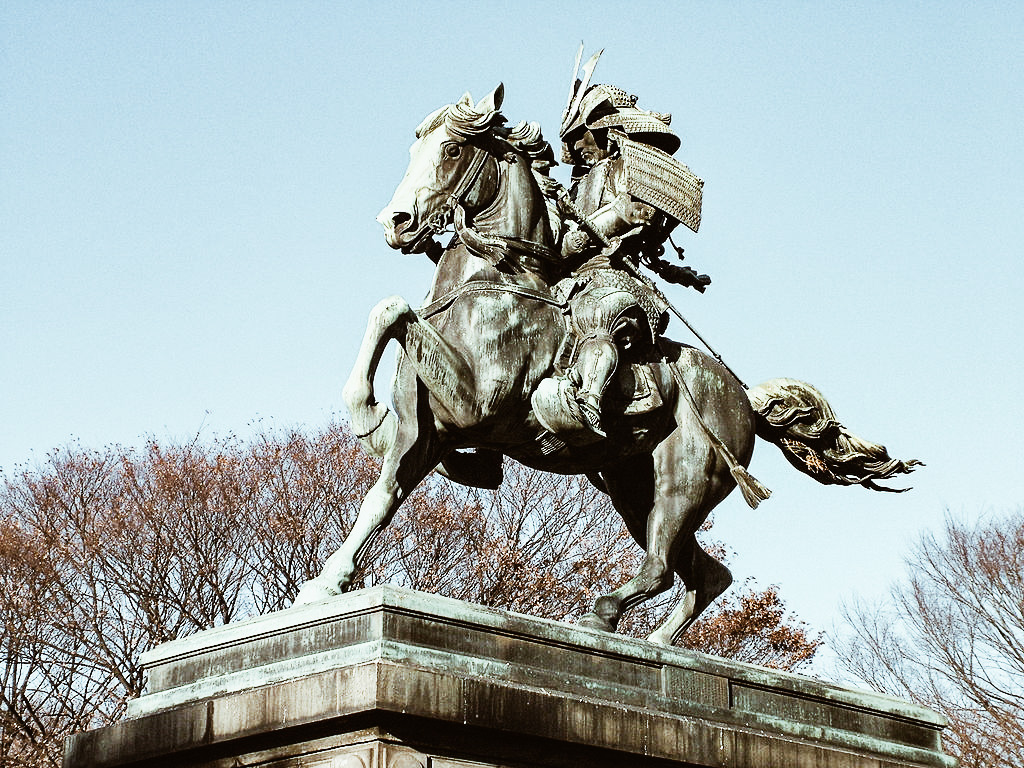
photo credits: wikipedia.org
La vita di Yamamoto Tsunetomo
Samurai della prefettura di Saga nella provincia di Hizen (Kyūshū), entrò al servizio di Mitsushige Nabeshima all'età di 9 anni, A vent'anni conobbe il monaco buddista Tannen, che aveva abbandonato il tempio in segno di protesta per la condanna di un altro monaco, e Ishida Ittei, un letterato confuciano consigliere di Nabeshima che era stato esiliato per più di 8 anni a causa della sua opposizione alla decisione di un daimyō.
Nel 1700, all morte del suo patrono, non scelse di accompagnarlo nella morte con il seppuku, perché Nabeshima aveva sempre condannato quella pratica, per questo decise di continuare a rispettare il suo volere. Yamamoto Tsunetomo decide di prendere i voti buddisti e di assumere il nome Jōchō ritirandosi in un eremo sulle montagna dopo alcuni problemi con il successore di Nabeshima. Diventato monaco buddhista della setta Zen Sōtō compose tra il 1709 e 1716 con l’allievo Tashiro Tsuramoto, lo Hagakure, l'opera sullo spirito e il codice di condotta del samurai. Tsunetomo chiese al discepolo di non pubblicare mai questi pensieri ma di dare alle fiamme il libro, ma il giovane Tsuramoto decise di renderlo pubblico
con il nome di Nabeshima Rongo, ovvero "i dialoghi di Nabeshima". Il libro per secoli fu adottato come codice dei Samurai e fu stampato solo nel 1906 con il titolo Hagakure (”All’ombra delle foglie”).

photo credits: amazon.com
Il tema principale di Hagakure è la morte, non come fine della vita, ma come eliminazione dell'io. Hagakure è una raccolta di principi morali e consigli come norme comportamentali e notizie storiche. Alcune norme di natura semplice, ad esempio "come licenziare un servo", mentre altri invece sono parte del Bushidō, di quell'insieme di principi che costituì per secoli l'etica di tutto il popolo giapponese.
Il libro scritto da Yamamoto Tsunetomo, che è originariamente di 11 volumi, non è mai stato tradotto integralmente in lingua italiana, perchè è spesso molto specifico sulla cultura giapponese da risultare ostico alla lettura degli italiani.
Lo Hagakure divenne uno dei testi più famosi sul bushidō intorno agli anni trenta.
Alcune delle frasi più famose del libro
“Ho scoperto che la Via del Samurai è la morte: è necessario prepararsi alla morte dal mattino alla sera, giorno dopo giorno.”
“Il Codice del Samurai va cercato nella morte. Si mediti quotidianamente sulla sua ineluttabilità. Ogni giorno, quando nulla turba il nostro corpo e la nostra mente, dobbiamo immaginarci squarciati da frecce, fucili, lance e spade, travolti da onde impetuose, avvolti dalle fiamme in un immenso rogo, folgorati da una saetta, scossi da un terremoto che non lascia scampo, precipitati in un dirupo senza fine, agonizzanti per una malattia o pronti al suicidio per la morte del nostro signore. E ogni giorno, immancabilmente, dobbiamo considerarci morti. È questa l’essenza del Codice del Samurai.”
“Ogni mattina e ogni sera dovremmo continuamente pensare alla morte, sentendoci già morti da sempre; in tal modo, saremo liberi di muoverci in ogni situazione.”
“Possiamo mantenere buoni rapporti con gli altri dando loro importanza ed evitando malintesi con le buone maniere e con vera umiltà, facendo le cose bene anche quando non sono utili a noi ma agli altri, come se fosse la prima volta che ci si incontra.”
“Chi è impaziente finisce per rovinare tutto e non riesce a compiere grandi imprese. Chi invece non si preoccupa del tempo porterà a termine la sua missione molto velocemente.”
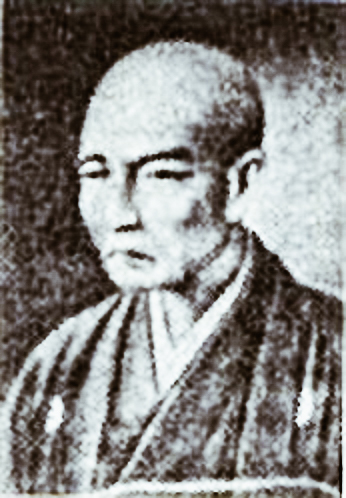
photo credits: wikipedia.org
14° Japan International Manga Award
14° Japan International Manga Award
scritto da: SaiKaiAngel
Se conoscete ed amate la cultura dei Manga, non potete non conoscere il MANGA AWARD! Sapete disegnare o semplicemente amate così tanto i manga da dedicarvi a loro buona parte della giornata? Pensiamo che dovreste fermarvi un attimo e leggere questo annuncio importantissimo. troviamo il positivo in un momento in cui dobbiamo necessariamente stare a casa! Dedichiamoci a rendere ancora migliori le nostre opere Manga e partecipiamo a queste bellissima iniziativa!
Il periodo di applicazione per il 14° Japan International MANGA Award, va dal 6 aprile 2020 al 19 giugno 2020. Artisti MANGA di tutto il mondo, PARTECIPATE!
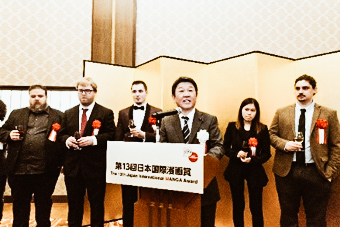
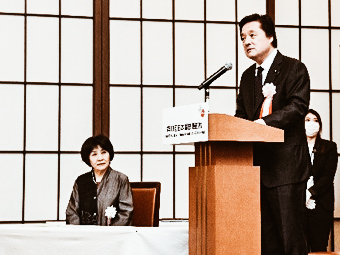
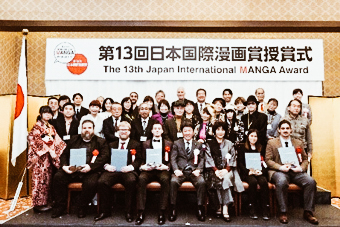
Qui di seguito le istruzioni, semplici ed immediate:
Perchè è importante?
Perchè il MANGA è molto più di due grandi occhi pieni di entusiasmo e divertimento. E una vera e propria CULTURA ed è anche un modo per distruggere i confini e promuovere scambi culturali internazionali!
Ci sono dei premi?
Certamente! Il Gold Award del Japan International MANGA Award per la migliore opera MANGA, il Silver Award a tre eccellenti opere e il Bronze Award ad altre undici opere.
I vincitori del Gold Award e del Silver Award, quindi non i vincitori del Bronze Award, potranno usufruire dell’invito in Giappone per 10 giorni in occasione della cerimonia di premiazione!
Come si fa a partecipare agli International Manga Award?
I MANGA devono essere composti da più di 16 pagine. È possibile sia per le opere MANGA già pubblicate che non, ovviamente non saranno accettate le opere vincitrici delle passate edizioni del Japan International Manga Awards.
Quali opere MANGA sono accettate?
Le opere MANGA devono essere state prodotte negli ultimi tre anni (2017-2020)
In che forma si accettano le opere MANGA?
Le opere MANGA devono essere presentate in forma stampata.
Le case editrici possono partecipare ai Manga Award?
Le case editrici overseas possono partecipare al Japan International MANGA Award, previa conferma da parte degli artisti MANGA di presentare il proprio lavoro.
L'artista o lo sceneggiatore dell'opera presentata deve essere un cittadino straniero. Anche il rappresentante che parteciperà all’invito per i vincitori del premio Gold e Silver devono essere cittadini stranieri
Quante opere si possono presentare?
Ogni partecipante deve presentare una sola opera. Nel caso di una raccolta di racconti, ne verrà accettato solamente uno. Non sono validi i duplicati.
Come funziona la candidatura per i Manga Award?
Visto il periodo che il mondo sta attraversando, il consolato giapponese a Milano ha organizzato un metodo semplificato per raccogliere le candidature. Infatti, per rendere più agevoli gli scambi, invitiamo tutti i candidati ad anticipare il modulo 14th Entry Form (LINK MODULO PDF PRESENTE SUL DRIVE) opportunamente compilato a questo indirizzo mail : culture@ml.mofa.go.jp .
Tuttavia, le deadline per l’invio dell’iscrizione rimangono invariate. Infatti, il periodo di registrazione è dal 6 aprile 2020 al 19 giugno 2020 e le candidature dovranno essere inviate necessariamente entro queste date.
In alternativa potete inviare il tutto alla P.O. Box ufficiale:
P.O.Box MBE193 Il 14 ° Comitato Esecutivo del Premio Internazionale MANGA del Giappone Shinjuku Oak Tower 2F, 6-8-1 Nishi-Shinjuku, Shinjuku-ku, Tokyo, Giappone CAP: 163-6002
Bisogna inviare due copie dell’opera, nonostante tutto potrebbero essere richieste copie aggiuntive nel caso di premio.
In allegato all’opera MANGA, deve esserci un modulo di iscrizione compilato in inglese o giapponese. I numeri devono essere indicati su ogni pagina dell'opera MANGA. Se l'opera MANGA non ha la forma di un libro, dovrà essere specificato.
Le opere MANGA saranno restituite?
No, le opere MANGA inviate non verranno restituite ai candidati. Mi raccomando quindi, se l'opera non è stata ancora pubblicata è consigliabile inviarne una copia dell'opera e conservare l'originale. Tenete conto che opere presentate potrebbero essere donate o esposte.
Il Comitato Esecutivo del Premio MANGA può caricare (parzialmente) le opere MANGA del vincitore sul proprio sito Web previa approvazione degli artisti.
Chi si occupa della selezione?
il 14° comitato di selezione del premio MANGA International Japan sarà il responsabile delle procedure di selezione.
Ricordate che la cerimonia di premiazione si terrà a Tokyo nel febbraio 2021.
Potete avere la possibilità non solo di vincere dei premi, non solo di far conoscere la vostra opera MANGA in tutto il mondo, ma anche di essere invitati in Giappone! Cosa state aspettando? Avete ancora tempo per iscrivervi e partecipare. Siamo curiosi di vedere le vostre opere MANGA, affrettatevi!! Rendete questo momento ancora più divertente e proficuo.
Ulteriori informazioni: manga-award.mofa.go.jp
Linee guida:
The 14th Japan International MANGA Award Guidelines for Application
The 14th Japan International MANGA Award Entry Form
Japan History: Minamoto No Yoshiie
Minamoto No Yoshiie, lo spirito del Samurai
scritto da: SaiKaiAngel
Minamoto No Yoshiie (1039 - 4 agosto 1106), incarna lo spirito del samurai. Fu il primo figlio di Minamoto Yoriyoshi, un famoso comandante.
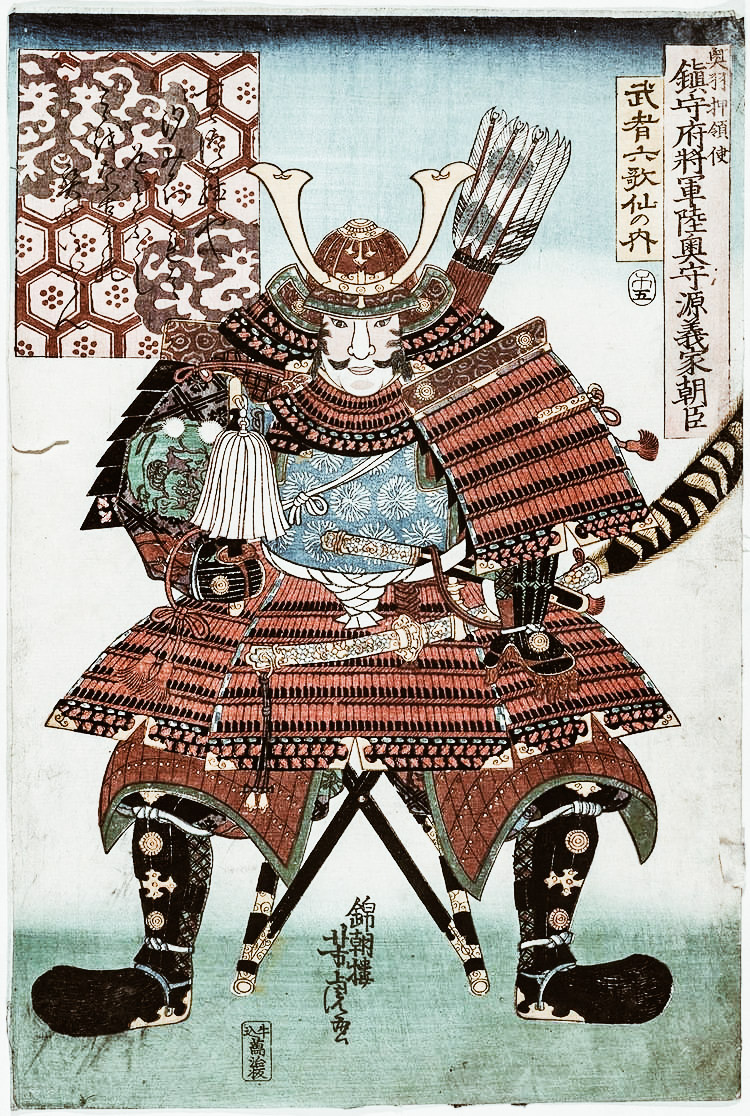
photo credit: alchetron.com
Nel 1051 Minamoto No Yoshiie fu incaricato di sconfiggere il clan Abe nella guerra Zenkunen (guerra dei primi nove anni) e il clan Kiyohara nella guerra di Gosannen (guerra dei tre anni successivi). Abe aveva ricoperto per anni importanti incarichi in questa regione lontana e proibitiva ed era giunto ad assumere una certa autonomia. Come Taira Masakado, Abe aveva avuto il compito di sottomettere i barbari settentrionali e, dal punto di vista della Corte, diventare essi stessi barbari. Sono stati infatti descritti come ebisu, un termine generico che è stato applicato anche ad Ainu.
Dopo la sua morte, Yoshiie fu elevato allo status di Kami: ribattezzato "Hachimantaro" che significa "figlio di Hachiman", il dio della guerra shintoista.
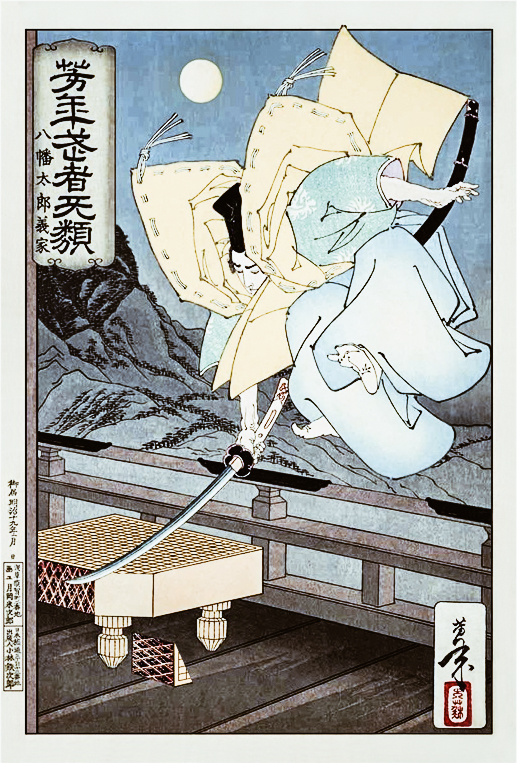
photo credit: wikipedia.org
La guerra Zenkunen
Nel 1050 il potere di Abe no Yoritoki, era diffuso nell'intera regione, e questo gli ha dato il permesso di riscuotere tributi e confiscare terre. ll governatore ufficiale, privato di ogni regione, chiese aiuto al governo imperiale. Minamoto no Yoriyoshi fu nominato allora nuovo governatore e inviato con il figlio contro il clan Abe.
La lotta durò dal 1051 al 1063, dodici anni di cui nove di guerra e tre di tregua. Yoshiie combatté al fianco del padre in tutti gli scontri, inclusa la battaglia di Kawasaki e l'assedio di Kuriyagawa.
Nel 1057 il figlio di Abe no Yoritoki, Abe no Sadato proseguì la guerra dopo la morte di suo padre.
Nel Mutzu Waki, omaggio alla reputazione del guerriero di Yoshiie, c’è il racconto di uno scambio avvenuto tra Yoshiie e Sadato durante la fuga di questo dalla fortezza sul fiume Kurika, durante le aggressioni dell'esercito dei Minamoto.
Hachimantarō, durante un inseguimento lungo il fiume Koromo gridò: "Signore, state state mostrando le spalle al nemico! Non vi vergognate? Giratevi un momento, ho qualcosa da dirvi." Quando Sadato si voltò, Yoshiie disse: "Il castello di Koromo è stato distrutto". Sadato, voltandosi, disse: "Nel corso degli anni i fili si sono aggrovigliati, e ciò mi addolora". A quel punto, Yoshiie ripose la freccia che aveva caricato, e tornò al suo campo. Nel mezzo di una battaglia così selvaggia, quello fu un atto da gentiluomo.
Yoshiie tornò a Kyoto nei primi mesi del 1063 con la Testa di Abe no Sadato e l'anno seguente prese come servitori parecchi seguaci degli Abe che aveva fatto prigionieri.
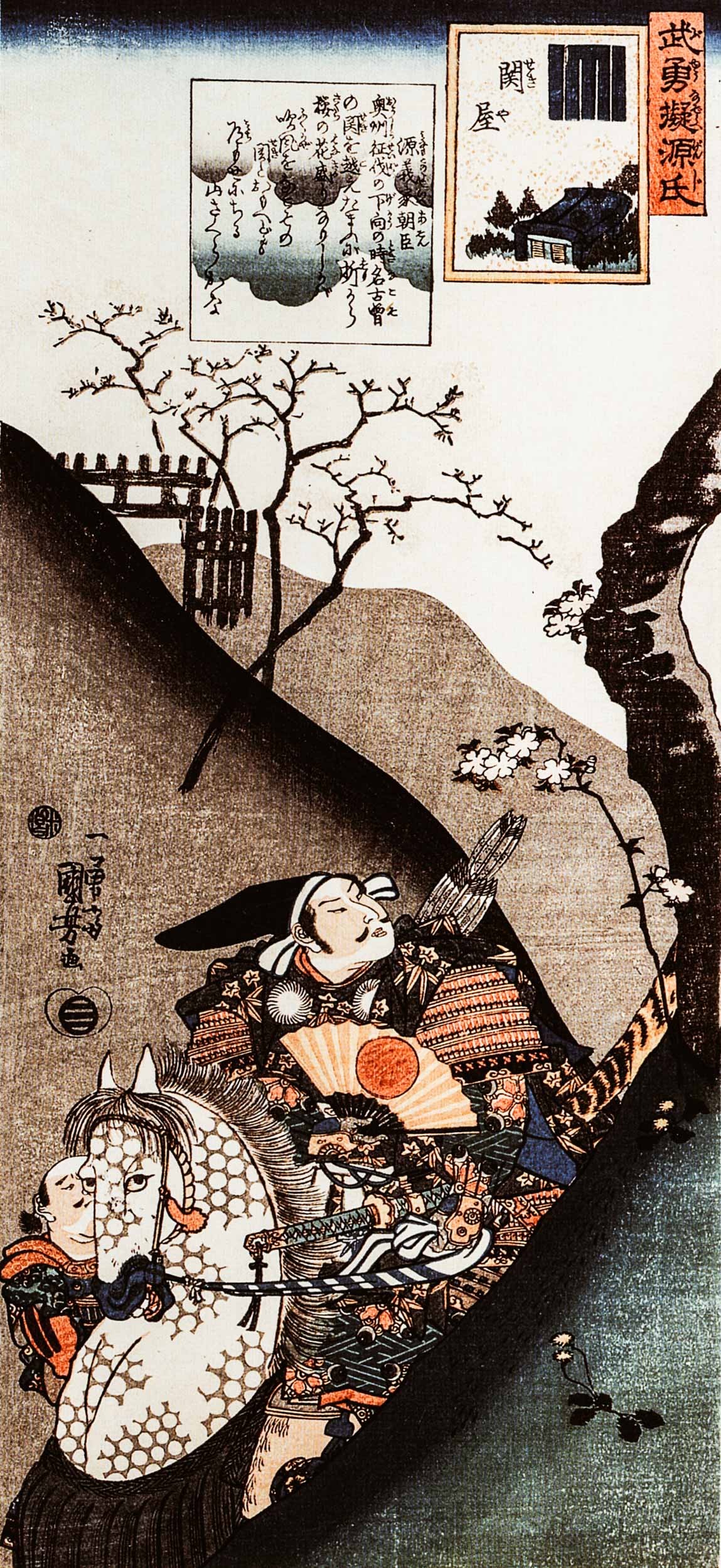
photo credit: wikipedia.org
Guerra Gosannen
Yoshiie fu comandante durante un altro importante conflitto del periodo Heian. Agli inizi del 1083, nominato governatore della provincia di Mutsu, si intromise per calmare gli animi all'interno del clan Kiyohara, in precedenza alleato dei Minamoto nella guerra contro gli Abe.
Nonostante questo, la lotta tra Kiyohara no Masahira, Narihira e Iehira sulla leadership del clan non si fermarono, e così Yoshiie si impegnò a riportare la pace nella regione. Lo scontro finale si svolse nel 1087 sulle palizzate di Kanazawa. Yoshiie, aiutato dal fratello minore Minamoto no Yoshimitsu e da Fujiwara Kiyohira, assaltò la posizione tenuta da Kiyohara no Iehira e da suo zio Kiyohara no Takahira. Il conflitto divenne noto come la successiva guerra dei tre anni e culminò a Numu (1086) quando Takahira e Iehira furono uccisi. Nel Kokon Chomonjū si narra che durante l'assedio di Kanezawa, Yoshiie abbia evitato un'imboscata notando uno stormo di uccelli prendere il volo da una foresta. Pur subendo grandi perdite nei suoi ranghi, si dice che Yoshiie sia stato un leader particolarmente efficace, riuscendo a tenere il morale alto e preservando la disciplina tra i guerrieri.
Minamoto No Yoshiie fu definito "Il Samurai dal più grande coraggio sotto al cielo". Mel 1098 fu concesso a Yoshiie di visitare la Corte imperiale, un raro onore che per sua stessa rarità indica il divario crescente tra la Corte e le case provinciali. Questa alienazione alla fine avrebbe contribuito all'eclissi dell'autorità imperiale da parte dei samurai alla fine del XII secolo.
Tuttavia, è difficile collocare Minamoto Yoshiie in un contesto storico. Il suo più grande contributo politico fu probabilmente il rafforzare la famiglia Minamoto, in particolare quei rami che risiedono nel Kanto. L'altro suo contributo è stato meno tangibile. La leggenda di Minamoto No Yoshiie, che emerse dalle sue guerre settentrionali e dalle cronache come un uomo di guerra colto, stabilì un modello per il futuro samurai che avrebbe influenzato le successive generazioni di guerrieri.
Japan History: Toyotomi Hideyoshi
Toyotomi Hideyoshi, il grande unificatore del Giappone
scritto da: SaiKaiAngel
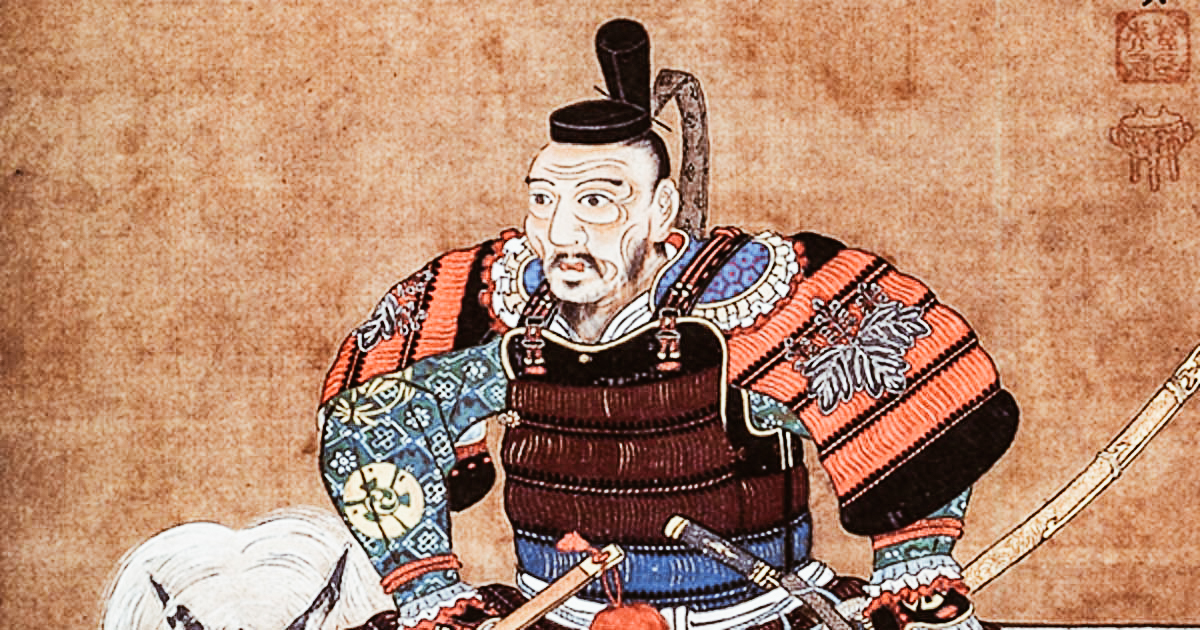
photo credits: ancient-origins.net
Toyotomi Hideyoshi (17 marzo 1537 - 18 settembre 1598) era un samurai, nonchè daimyō, successore di Oda Nobunaga come “grande unificatore” del Giappone, ponendo fine al periodo Sengoku. Il periodo del suo dominio è chiamato Momoyama, dal nome del castello di Hideyoshi. Sembra che la sua nascita fu nella provincia di Owari, la casa del clan Oda (l'attuale Nagoya nella prefettura di Aichi). Figlio di un contadino-ashigaru di nome Yaemon. Sembra che il suo nome d'infanzia fosse Hiyoshi-maru. Suo padre morì quando Hideyoshi aveva 7 anni.
Hideyoshi fu mandato a studiare in un tempio da giovane, ma rifiutò quella vita per andare a caccia di avventure. Sotto il nome Kinoshita Tōkichirō si unì per la prima volta al clan Imagawa come servitore di un sovrano locale di nome Matsushita Yukitsuna. Ha viaggiato fino alle terre di Imagawa Yoshimoto, daimyō della provincia di Suruga, e lo ha servito solo per fuggire con una somma di denaro affidatagli da Matsushita Yukitsuna.
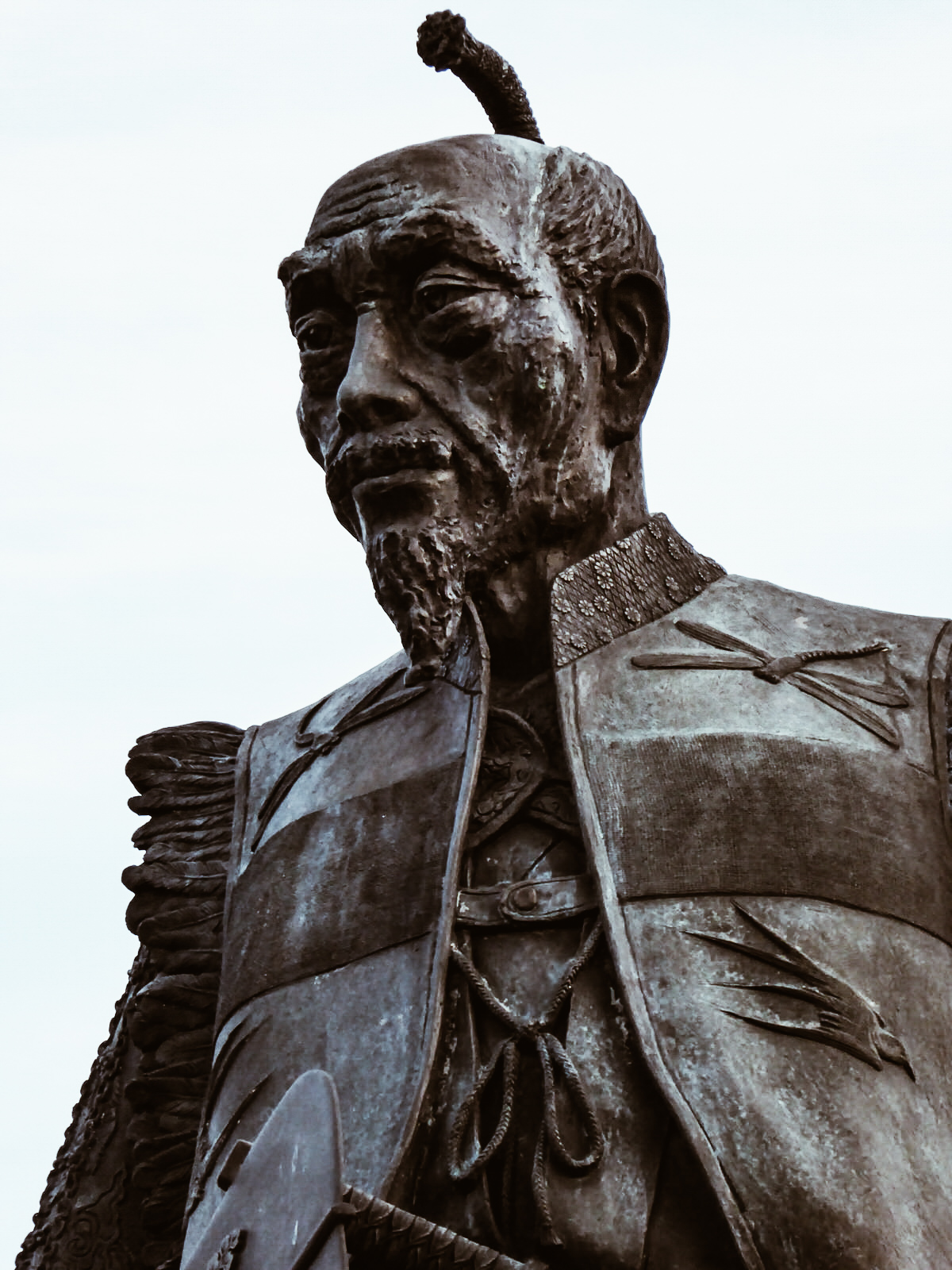
photo credits: samurai-world.com
Il giovane Toyotomi Hideyoshi guidò un piccolo gruppo per attaccare il castello sul monte Inaba e nel 1558, si unì al clan Oda, guidato da Oda Nobunaga, come ashigaru (lett. "piedi leggeri"che furono impiegati nei conflitti del Giappone feudale dalla casta dei samurai.)
Divenne uno dei portatori di sandali di Nobunaga ed era presente nella battaglia di Okehazama nel 1560 quando Nobunaga sconfisse Imagawa Yoshimoto per diventare uno dei più potenti signori della guerra nel periodo Sengoku. Sembra anche che abbia supervisionato la riparazione del castello di Kiyosu gestendone la cucina.
Nel 1561 Hideyoshi sposò la figlia adottiva di Asano Nagakatsu. Ha effettuato riparazioni sul castello di Sunomata con suo fratello minore Toyotomi Hidenaga, Hachisuka Masakatsu e Maeno Nagayasu. Costruì un forte a Sunomata, di notte scoprendo anche una via segreta verso il Monte Inaba
Assedio al castello di Inabayama
Hideyoshi ebbe molto successo come negoziatore. Nel 1564, riuscì a convincere i signori della guerra Mino a disertare il clan Saitō. Hideyoshi si avvicinò a molti samurai convincendoli a sottomettersi a Nobunaga.
La facile vittoria di Nobunaga al castello di Inabayama nel 1567 fu in gran parte dovuta agli sforzi di Hideyoshi per questo divenne uno dei generali più illustri di Nobunaga, alla fine prendendo il nome di Hashiba Hideyoshi. Il nuovo cognome includeva due personaggi, uno ciascuno degli altri due uomini di Oda, Niwa Nagahide e Shibata Katsuie.
Battaglia di Anegawa
Hideyoshi guidò le truppe nella battaglia di Anegawa nel 1570 in cui Oda Nobunaga si alleò con Tokugawa Ieyasu per assediare due fortezze dei clan Azai e Asakura. Partecipò all'assedio di Nagashima nel 1573 e nello stesso anno, Nobunaga nominò Hideyoshi daimyō di tre distretti nella parte settentrionale della Provincia di Ōmi. Hideyoshi si trasferì a Kunitomo e ribattezzò la città di Nagahama in omaggio a Nobunaga. In seguito Hideyoshi si trasferì nel porto di Imahama sul lago Biwa e prese il controllo della vicina fabbrica di armi da fuoco Kunitomo che era stata istituita alcuni anni prima dagli Azai e dagli Asakura facendo aumentare la sua produzione.
Inoltre, ha combattuto nella battaglia di Nagashino dopodichè Nobunaga mandò Hideyoshi al castello di Himeji per conquistare la regione di Chūgoku dal clan Mori nel 1576.
Nel 1577, combattè nella battaglia di Tedorigawa, nell'assedio di Miki, nell'assedio di Itami (1579) e nell'assedio di Takamatsu del 1582.
Battaglia di Yamazaki e conflitto con Katsuie
Dopo gli omicidi di Honnō-ji di Oda Nobunaga e del suo figlio maggiore Nobutada nel 1582 per mano di Akechi Mitsuhide, Hideyoshi, in cerca di vendetta per la morte del suo amato signore, fece pace con il clan Mōri e sconfisse Akechi nella battaglia di Yamazaki .
Successivamente, essendo in una buona posizione, chiamò il potente daimyo a Kiyosu in modo che potessero determinare l'erede di Nobunaga. Oda Nobukatsu e Oda Nobutaka litigarono, quindi l’erede divenne Samboshi, nipote di Nobunaga. Avendo conquistato il sostegno degli altri due anziani di Oda, Niwa Nagahide e Ikeda Tsuneoki, Hideyoshi prese la posizione di Hidenobu e la sua influenza sul clan Oda. Distribuì le province di Nobunaga tra i generali e formò un consiglio di quattro generali. La tensione tra Hideyoshi e Katsuie sfociò nella battaglia di Shizugatake dell'anno successivo in cui Hideyoshi distrusse le forze di Katsuie. A quel punto Hideyoshi aveva affrontato la maggior parte del clan Oda e il controllo di 30 province.
Costruzione del castello di Osaka
Nel 1582, Hideyoshi iniziò la costruzione del castello di Osaka sul sito del tempio Ishiyama Hongan-ji distrutto da Nobunaga; questo divenne l'ultima roccaforte del clan Toyotomi dopo la morte di Hideyoshi.
Battaglia di Komaki e Nagakute
Oda Nobukatsu, ostile a Hideyoshi, si alleò con Tokugawa Ieyasu e le due parti combatterono nella battaglia di Komaki e Nagakute. Alla fine risultò in una situazione di stallo, anche se le forze di Hideyoshi subirono un duro colpo. Infine, Hideyoshi fece pace con Nobukatsu, ponendo fine al pretesto per la guerra tra i clan Tokugawa e Hashiba. Ieyasu alla fine accettò di diventare un vassallo di Hideyoshi.
Hideyoshi non ha mai ottenuto il titolo di shōgun, ma fece in modo di farsi adottare da Konoe Sakihisa, uno degli uomini più nobili appartenenti al clan Fujiwara e assicurò una successione di titoli di alta corte tra cui, nel 1585, la prestigiosa posizione di Imperial Regent (kampaku). Nel 1586, Hideyoshi ricevette ufficialmente il nome del nuovo clan Toyotomi dalla corte imperiale e costruì, il Jurakudai, un sontuoso palazzo, nel 1587 intrqattenendo l'imperatore regnante, Go-Yōzei, l'anno successivo.
Giappone unificato sotto Toyotomi Hideyoshi
Successivamente, Hideyoshi soggiogò la provincia di Kii e conquistò Shikoku sotto il clan Chōsokabe. Assunse poi il controllo della provincia di Etchū conquistando anche Kyūshū.
Nel 1587 Hideyoshi bandì i missionari cristiani da Kyūshū per esercitare un maggiore controllo sui daimyōs Kirishitani.
Nel 1588 proibì ai comuni contadini di possedere armi e iniziò a confiscarle. Le spade furono fuse per creare una statua del Buddha. Questa misura fermò efficacemente le rivolte dei contadini e assicurò una maggiore stabilità a spese della libertà dei singoli.
Assedio di Odawara
L'assedio di Odawara del 1590 contro il clan Hōjō nella regione di Kantō eliminò l'ultima resistenza all'autorità di Hideyoshi. La sua vittoria significò la fine del periodo Sengoku. Durante questo assedio, Hideyoshi offrì a Ieyasu le otto province governate da Hōjō nella regione di Kantō in cambio della sottomissione delle cinque province di Ieyasu che accettò questa proposta.
Nel febbraio del 1591, Hideyoshi ordinò a Sen no Rikyū di suicidarsi, probabilmente in uno dei suoi scoppi d'ira. Rikyū era stato un fidato sostenitore e maestro della cerimonia del tè sotto Hideyoshi e Nobunaga apportò inoltre cambiamenti significativi all'estetica della cerimonia del tè che ebbe un'influenza duratura su molti aspetti della cultura giapponese. Anche dopo la morte di Rikyū, si dice che Hideyoshi abbia costruito i suoi numerosi progetti di costruzione basati sull'estetica promossa da Rikyū, forse suggerendo che si pentì delle sue azioni.
Dopo la morte di Rikyū, Hideyoshi portò la cerimonia del tè a Noh, che aveva studiato da quando era diventato reggente imperiale.
La stabilità della dinastia Toyotomi dopo la morte di Hideyoshi fu messa in dubbio con la morte di suo figlio Tsurumatsu nel settembre del 1591. Il bambino di tre anni era il suo unico figlio. Quando il suo fratellastro Hidenaga morì poco dopo, Hideyoshi nominò suo nipote Hidetsugu suo erede, adottandolo nel gennaio del 1592. Hideyoshi si dimise come kampaku per ottenere il titolo di taikō e Hidetsugu gli successe come kampaku.
Houkokubyo (Mausoleo di Toyotomi Hideyoshi) Higashiyama-ku, Kyoto
Nel momento in cui la sua salute cominciava a vacillare, Hideyoshi ha portato avanti il sogno di Oda Nobunaga, quello di una conquista giapponese fino alla Cina, arrivando alla dinastia Ming attraverso la Corea.
Hideyoshi chiese ai coreani un passaggio per la Cina nel 1587, ma ottenne un rifiuto, perchè la Corea era alleata con la Cina e nell'aprile e luglio del 1591 rifiutò anche la richiesta di passaggio attraverso la Corea per paura di mettere a rischio la sicurezza. Quindi, nell'agosto del 1591, Hideyoshi ordinò che iniziassero i preparativi per un'invasione della Corea.
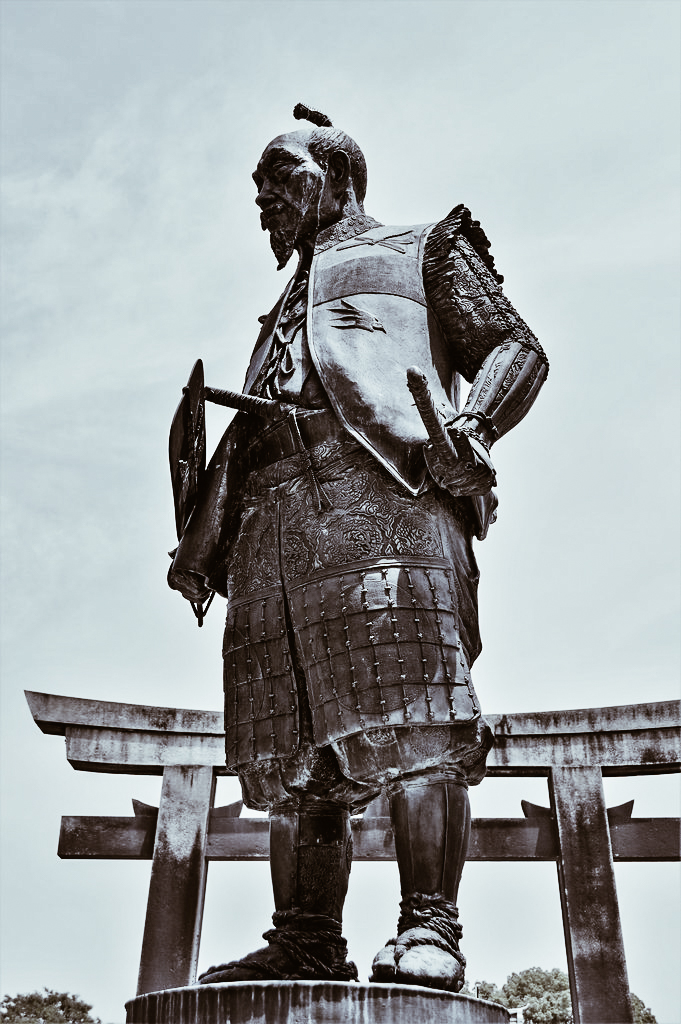
photo credits: flickr.com
Prima campagna contro la Corea
Nella prima campagna, Hideyoshi nominò Ukita Hideie come maresciallo e lo fece entrare nella penisola coreana nell'aprile del 1592. Konishi Yukinaga a quel punto occupò Seoul il 19 giugno. Dopo la caduta di Seoul , I comandanti giapponesi hanno tenuto un consiglio di guerra e hanno determinato obiettivi di sottomissione chiamati Hachidokuniwari da ciascun corpo. In soli quattro mesi, le forze di Hideyoshi fecero rotta verso la Manciuria e occuparono gran parte della Corea. Il re coreano Seonjo fuggì a Uiju e chiese l'intervento militare dalla Cina. Nel 1593, l'imperatore Wanli di Ming China inviò un esercito sotto il generale Li Rusong per bloccare la prevista invasione giapponese della Cina e riconquistare la penisola coreana. L'esercito Ming di 43.000 soldati guidati da Li Ru-Song ha continuato ad attaccare Pyongyang.
Il 7 gennaio 1593, le forze di soccorso di Ming sotto Li catturarono ancora Pyongyang e circondarono Seoul, ma Kobayakawa Takakage, Ukita Hideie, Tachibana Muneshige e Kikkawa Hiroie vinsero la Battaglia di Byeokjegwan nella periferia di Seoul. Alla fine della prima campagna, l'intera marina giapponese fu distrutta dall'ammiraglio Yi Sun-sin della Corea, la cui base era situata in una parte della Corea che i giapponesi non potevano controllare. Questo, in effetti, mise fine al sogno del Giappone di conquistare la Cina poiché i coreani semplicemente distrussero la capacità del Giappone di rifornire nuovamente le loro truppe impantanate a Pyongyang.
Disputa di successione
La nascita del secondo figlio di Hideyoshi nel 1593, Hideyori, creò un problema di successione. Per evitarlo, Hideyoshi esiliò suo nipote ed erede Hidetsugu sul Monte Kōya e poi gli ordinò di suicidarsi nell'agosto del 1595. I membri della famiglia di Hidetsugu che non seguirono il suo esempio furono poi assassinati a Kyoto.
Nel gennaio del 1597, Toyotomi Hideyoshi fece arrestare ventisei cristiani come esempio di giapponesi che volevano convertirsi al cristianesimo. Sono conosciuti come i ventisei martiri del Giappone. Includevano cinque missionari francescani europei, un missionario francescano messicano, tre gesuiti giapponesi e diciassette laici giapponesi, tra cui tre giovani ragazzi. Il 5 febbraio furono giustiziati a Nagasaki per crocifissione pubblica.
Seconda campagna contro la Corea
Dopo diversi anni di trattative Hideyoshi nominò Kobayakawa Hideaki per condurre una rinnovata invasione della Corea, ma i loro sforzi sulla penisola ottennero meno successo. Le truppe giapponesi rimasero bloccate nella provincia di Gyeongsang. Nel giugno del 1598, le forze giapponesi respinsero diverse offensive cinesi a Suncheon e Sacheon, ma non furono in grado di compiere ulteriori progressi mentre l'esercito Ming si preparava per un assalto finale. I coreani hanno continuamente molestato le forze giapponesi, mentre la battaglia di Hideyoshi a Sacheon fu una grande vittoria del Giappone.
Toyotomi Hideyoshi morì il 18 settembre 1598. Era delirante e le sue ultime parole, consegnate ai suoi generali più vicini, furono “Dipenderò da voi per tutto. Non ho altri pensieri da lasciare alle spalle. È triste separarsi da voi ''. La sua morte è stata tenuta segreta dal Consiglio dei Cinque Anziani per preservare il morale e alle forze giapponesi in Corea è stato ordinato di ritirarsi in Giappone dal Consiglio dei Cinque Anziani (Tokugawa Ieyasu, Maeda Toshiie , Uesugi Kakekatsu, Mori Terumoto, Ukita Hideie).
Visto che non erano riuscite a catturare la Corea, le forze di Hideyoshi non furono in grado nemmeno di raggiungere la Cina. La forza di combattimento si esaurì, i suoi vassalli in contrasto sulla responsabilità per il fallimento e i clan che erano fedeli al nome Toyotomi si indebolirono. Il sogno di una conquista giapponese della Cina è stato messo in attesa indefinitamente. Il governo Tokugawa in seguito non solo proibì ulteriori spedizioni militari nella terraferma asiatica, ma chiuse il Giappone a quasi tutti gli stranieri durante gli anni dello shogunato di Tokugawa. Fu solo alla fine del 19° secolo che il Giappone combatté di nuovo una guerra contro la Cina attraverso la Corea, usando più o meno lo stesso percorso usato dalla forza di Hideyoshi.
Dopo la sua morte, gli altri membri del Consiglio dei cinque reggenti non furono in grado di tenere sotto controllo le ambizioni di Tokugawa Ieyasu.
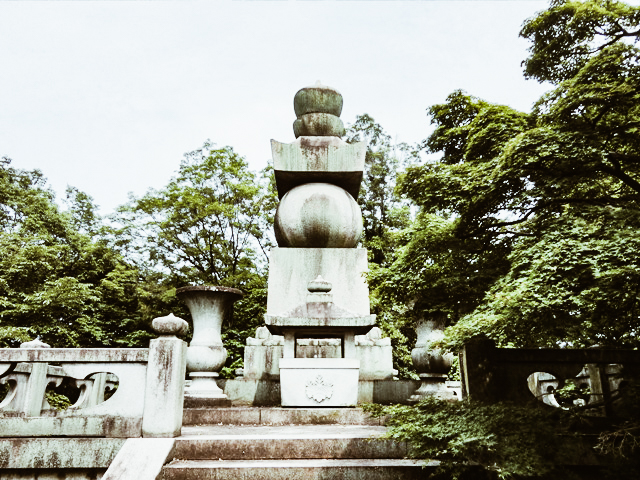
photo credits: jekyoto.wordpress.com
L'eredità culturale di Toyotomi Hideyoshi
Toyotomi Hideyoshi ha cambiato la società giapponese in molti modi.
Le riforme di classe hanno interessato cittadini e guerrieri. Durante il periodo Sengoku, era diventato comune che i contadini diventassero guerrieri o che i samurai coltivassero a causa della costante incertezza causata dalla mancanza di governo centralizzato e da una pace sempre provvisoria. Dopo aver preso il controllo, Hideyoshi decretò che tutti i contadini fossero completamente disarmati e che i samurai lasciassero la terra per stabilirsi nelle città del castello. Ciò ha rafforzato il sistema di classi sociali per i successivi 300 anni.
Inoltre, ha ordinato un censimento completo del Giappone. Dopo questo, chiese a tutti i giapponesi di rimanere nei rispettivi han (feudi) a meno che non avessero ottenuto il permesso ufficiale di andare altrove.
Nel 1590, Hideyoshi completò la costruzione del Castello di Osaka, il più grande di tutto il Giappone, per proteggere gli approcci occidentali a Kyoto. Nello stesso anno, vietò il "lavoro non libero" e la schiavitù, ma le forme di contratto e di lavoro forzato andarono avanti ugualmente.
Hideyoshi ha anche influenzato la cultura materiale del Giappone. Ha speso tempo e denaro per la cerimonia del tè, collezionando strumenti, sponsorizzando sontuosi eventi sociali e patrocinando acclamati maestri. Man mano che l'interesse per la cerimonia del tè cresceva tra la classe dirigente, non solo furono confiscate grandi quantità di preziosi articoli in ceramica, ma molti artigiani coreani furono trasferiti con la forza in Giappone.
Ispirato all'abbagliante padiglione d'oro di Kyoto, fece costruire la Golden Tea Room, che era coperta con una foglia d'oro e foderata all'interno con un gossamer rosso. Usando questa innovazione mobile, è stato in grado di praticare la cerimonia del tè ovunque andasse, proiettando con forza il suo potere e lo status senza pari al suo arrivo.
Politicamente, ha istituito un sistema governativo che ha bilanciato i più potenti signori della guerra giapponesi. Fu creato un consiglio per includere i signori più influenti.
Poco prima della sua morte, Hideyoshi sperava di istituire un sistema abbastanza stabile per sopravvivere fino a quando suo figlio non fosse divenuto abbastanza grande da diventare il prossimo leader. Fu formato un Consiglio dei Cinque Anziani (go-tairō), composto dai cinque daimyō più potenti. Dopo la morte di Maeda Toshiie, tuttavia, Tokugawa Ieyasu iniziò a stringere alleanze, compresi i matrimoni politici. Alla fine, le forze pro-Toyotomi hanno combattuto contro i Tokugawa nella battaglia di Sekigahara. Ieyasu vinse e ricevette il titolo di Seii-Tai Shōgun due anni dopo.
Gli altri nomi di Toyotomi Hideyoshi
Alla nascita, gli fu dato il nome Hiyoshi-Maru. A genpuku, prese il nome Kinoshita Tōkichirō. Più tardi, gli fu dato il cognome Hashiba e l'ufficio della corte onoraria Chikuzen no Kami; di conseguenza, è stato designato Hashiba Chikuzen no Kami Hideyoshi.
Toyotomi Hideyoshi aveva ricevuto il soprannome di Kozaru, che significa "piccola scimmia", dal suo signore Oda Nobunaga perché i suoi lineamenti del viso e la sua forma magra somigliavano a quelli di una scimmia. Era anche conosciuto come il "ratto calvo".
Hideyoshi lasciò un'eredità influente e duratura, tra cui la restrizione al possesso di armi da parte del samurai, la costruzione e il restauro di molti templi, alcuni dei quali sono ancora visibili a Kyoto, e le invasioni giapponesi della Corea (1592-1598).
Quaran, la mascotte ufficiale della quarantena del Giappone
Quaran, la mascotte ufficiale della quarantena del Giappone
scritto da: SaiKaiAngel | fonte: TimeOut Tokyo
Conosciamo Quaran, la mascotte ufficiale della quarantena del Giappone! Proprio così, anche questa volta il Giappone ha deciso di darci un messaggio importante pur mantenendo il sorriso.
Il mondo intero sta passando un momento difficilissimo, lottando contro la pandemia di Covid-19. In questo momento, ovunque si stanno chiudendo ditte, musei, scuole e addirittura intere città, spingendo le persone ad attivarsi con lo smart-working. Tutto questo durerà fino alla fine di questa emergenza.

E qui entra in gioco Quaran, una mascotte creata dal Ministero della salute giapponese per far capire l’importanza di stare a casa e ricordando anche le distanze di sicurezza. Viene descritta come una piccola fata con una Q sulla fronte, uno scudo e gli occhiali protettivi. Date un’occhiata anche alla sua schiena: con la coda si forma una Q, la Q di Quaran, la Q di Quarantena. La descrizione, come dicevamo, parla di una fata di piccole dimensioni che ci ricorda come evitare il virus rispettando le distanze ed evitare assembramenti, ma quando la incontriamo è una mascotte a grandezza naturale! Dove si può trovare maggiormente questo pupazzo? Negli aeroporti in Giappone, ma si dice che viaggi in tutto il mondo per prevenire atteggiamenti illegali che potrebbero diffondere ancora di più il virus Covid-19, proteggerci con il suo scudo e il suo buon senso.
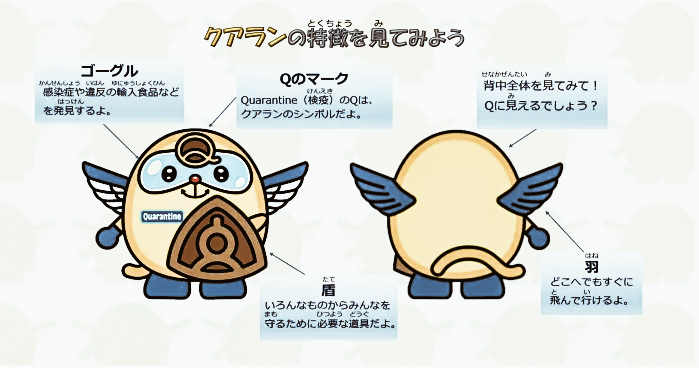
Quaran è stata creata anche per promuovere il lavoro del Quarantine Information Office, sotto il controllo del Ministero della Salute.
Non solo! Quaran ha addirittura un sito tutto suo, merita uno sguardo molto attento. Stai al sicuro, mondo! Quaran ci aiuterà a vivere tutto con responsabilità, buon senso, prevenzione, ma sempre un un sorriso. Un sorriso, ciò che non deve mai mancare mentre lottiamo.
Fonte: TimeOut Tokyo | Photo credits: forth.go.jp








